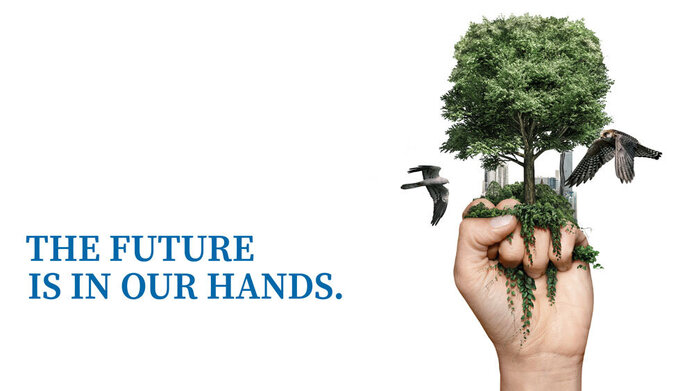PFAS: Chemicals for eternity?

Environment and Climate Research Hub (ECH)
The Environment and Climate Research Hub (ECH) is a new multidisciplinary research network within the University of Vienna. It is dedicated to connecting researchers addressing environment, climate, and sustainability from different academic viewpoints. More about the objectives of the network.
Currently, the ECH has 65 members from different faculties and departments of the University of Vienna. All of them carry out research in the field of environment and climate. Thilo Hofmann is co-heading the ECH together with Sabine Pahl.
When the miraculous material makes sick
However, soon the number of people suffering from autoimmune diseases increased. The cases of kidney cancer in connection with PFAS increased dramatically and vaccinations did not exert their intended effect. What industrial enterprises denied for a long time, we know better today: This miraculous material makes us sick.
The EU put this group of substances on a red list and intends to ban it entirely by 2025 in case of dispensable applications. In addition, the European Food Safety Authority (EFSA) has drastically reduced the threshold for the tolerable weekly intake of PFAS to only 4.4 nanograms per kilogram of body weight per week (see Environment Agency Austria).
PFAS disrupt the Ruhr river ecosystem
However, this amount of 4.4 nanograms is found regularly already now in samples of rivers and precipitation, both of which are often sources of our drinking water supply, emphasises Hofmann, who conducted research in the Ruhrgebiet region in Germany for his doctoral thesis. When he studied the Ruhr river in the 1990s, the river provided freshwater to the entire region, as it has been doing for several hundred years already. People filtered the Ruhr’s surface water by means of sand through a simple procedure and drank it. “These times are over.” In the meanwhile, large activated charcoal facilities are required to keep the potable water in the Ruhr region free from, at least, some PFAS.
PFAS Report 2022 in Austria
In a study by the Environment Agency Austria in cooperation with the Department of Food Chemistry and Toxicology of the University of Vienna, the researchers found PFAS values that exceeded the permissible threshold in the urine of all participating children (to the PFAS Report of the Environment Agency Austria, in German). This is no surprise to Thilo Hofmann: “We take up PFAS through our nutrition, cosmetics or drugs and household dust”. The PFAS concentration in urine was significantly higher in older children, from a statistical point of view. The researchers did not find any difference in PFAS concentrations between girls and boys or between individual regions (Environment Agency Austria, 2021).
PFAS: Forever chemicals
Sewage sludge from biogas plants – which is enriched with residues from the paper industry, which in turn are coated with PFAS – has permanently contaminated the soil in the Ruhr region. As soon as the chemicals made their way into the environment, it is actually not so easy to break this stable compound, which gave PFAS the nickname ‘forever chemicals’. Also in Austria there are several regions contaminated with PFAS, such as the area in the proximity of the Salzburg airport or the towns of Leibnitz and Lebring in Styria. In these cases, it is not sewage sludge but firefighting foam that is responsible for the contamination of groundwater.

How to avoid PFAS in everyday life
"PFAS are everywhere. This is why it is hard to protect ourselves from them," explains Hofmann, "But we can try to avoid high levels of exposure." The expert has several suggestions for you:
- Use uncoated kitchen equipment. Rather rely on glass, metal or ceramics in the kitchen.
- When buying outdoor clothes, look out for the “PFAS-free” label.
- Use waterproof spray for shoes, for example, only outdoors or protect yourself with a protective mask.
- When buying cosmetics, make use of apps that check the ingredients, among others, for PFAS (“fluoro” usually means PFAS).
- Purchase furniture and carpets that are free of PFAS. (Foto: © iStock)
Remedying damage?
Depending on the concrete situation, it might be almost impossible to remedy a damage caused by PFAS. "Often, very large areas are contaminated. In addition, buildings and land development on the surface complicate access," explains Hofmann. Therefore, Hofmann is looking for opportunities to retain PFAS residues in soil and ground water in-situ, and, ideally, to decompose them.
For this, he acquired several million euros of funding for a project conducted as part of a research consortium together with TU Wien and the Austrian Institute of Technology (AIT), in which scientists and business partners are working closely together. By means of high-resolution mass spectrometry, the researchers detect the substances and their degradation products. In the lab, they try to simulate the variable conditions existing in nature and test different approaches. The scientists have high hopes for the use of modern nanotechnology, namely a combination of green vegetable coal and non-valent nano-iron. Both industry partners in the project are then responsible for adding this in cement pillars or bringing it to deep soil layers by means of a lance. "We do not know if it will actually work, but at least we have a solution".
PFAS research is team work
In a joint project between the University of Vienna, TU Wien and the AIT led by Thomas Reichenauer, Thilo Hofmann and his co-researchers are tackling PFAS from different research perspectives. They dive deep into the analytics and patterns of this group of substances and work on fingerprints and the occurrence of PFAS as well as remedy options. Their project started on 1 January 2024. It is funded by the Federal Ministry for Climate Action, Environment, Energy, Mobility, Innovation and Technology through the Kommunal-Kredit Public Consulting (KPC) with 2.24 million euros. More about the project.
New ways of assessing chemicals
The story is repeating itself, as exemplified by polychlorinated biphenyls (PCBs): These compounds known to cause cancer were used, among others, for building transformers and windows. Although they have been banned in many countries for more than 30 years now, their concentrations are still raising in marine ecosystems, says Hofmann, 80 % of them can still be found in the environment. PCBs have only a low acute toxicity, but a high chronic toxicity, even at very low concentrations. Now we can observe the same in the case of PFAS, the most persistent group of substances ever developed by humans and introduced into the environment.
Due to these dramatic and recurring incidents, Hofmann argues that we need to find new ways of assessing chemicals and in materials development. “In general, new compounds are assessed according to their acute toxicity, not according to their persistence. But the consequences of chronic, long-term doses in low concentrations are very difficult to assess. We often see the consequences only decades later. This is why we have to ensure for all compounds ending up in the environment that they are no ‘forever chemicals’, which means that they degrade completely without toxic degradation products. It is good to limit damage but it is even better to avoid damage in the first place. (hm)
University of Vienna and BASF launch research collaboration on biodegradable plastics in compost
Researchers from the Department of Environmental Geosciences, led by Thilo Hofmann, are joining forces with BASF to better understand the behavior of biodegradable plastics in compost. "The collaboration will enable us to make important advances in environmentally friendly plastics. We want to use innovative methods to find out under what conditions and in what time frame the complete degradation of plastics in compost is guaranteed and how this process can be monitored," explains Thilo Hofmann. More about the new research cooperation
Together with Sabine Pahl, he is heading the new Environment and Climate Research Hub.